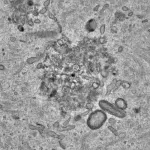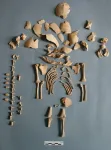(Press-News.org) Older people may be at greater risk of developing pancreatic cancer and have poorer prognoses because of age-related changes in cells in the pancreas called fibroblasts, according to research led by investigators from the Johns Hopkins Kimmel Cancer Center, the Johns Hopkins Bloomberg School of Public Health and the Bloomberg~Kimmel Institute for Cancer Immunotherapy.
The study, published online Feb. 8 in Cancer Research, provides clues as to why pancreatic cancer is more common and aggressive in older people. It may also help scientists develop new therapeutic approaches for this difficult-to-treat cancer. The study showed that aging alters fibroblasts in ways that enable them to promote pancreatic cancer tumor growth.
“Older fibroblasts release proteins that directly affect pancreatic cancer cells and ultimately lead to the growth and spread of pancreatic cancer tumors,” says the study’s lead author, Daniel Zabransky, M.D., Ph.D., assistant professor of oncology at the Johns Hopkins University School of Medicine. “The younger fibroblasts did not have these capabilities. We think this is a key reason why we see pancreatic cancer more commonly in older patients.”
Zabransky and his colleagues compared samples of pancreatic fibroblasts from patients older than 55 with pancreatic fibroblasts from patients younger than 35. They discovered that the cells from older patients behave very differently than younger ones. To find out why, they compared the proteins released by the younger and older cells and noted profound differences.
They determined that a critical change in older pancreatic fibroblasts is that they release more of a protein called growth/differentiation factor 15 (GDF-15). When the team treated young mice with pancreatic tumors with GDF-15, it caused the tumors to grow more rapidly, just as they do in older mice. Older mice that were genetically engineered to lack the gene encoding GDF-15 had reduced pancreatic tumor growth.
Experiments in human cells and mouse models revealed that GDF-15 activates the AKT signaling pathway in an age-dependent manner. The discovery was a surprise because the AKT pathway is typically not very active in mouse models of pancreatic cancer, Zabransky says. However, most studies look only at young mice. Experimental drugs already exist that inhibit the AKT pathway. When the team tested AKT-inhibiting drugs in mouse models of pancreatic cancer, they found the drugs reduced tumor growth in mice with aged fibroblasts. However, it had no effect in mice with young fibroblasts. Zabransky and his colleagues next plan to study age-related changes in other cells found in pancreatic cancer tumors, including immune cells, and their impact on pancreatic cancer.
Previous work by senior study author Ashani Weeraratna, Ph.D., co-chair of the Cancer Invasion and Metastasis Program and associate director for laboratory research for the Johns Hopkins Kimmel Cancer Center, demonstrated the importance of age-related changes in melanoma, a finding the team has now extended to pancreatic cancer. Weeraratna also is the E.V. McCollum Professor and chair of the Department of Biochemistry and Molecular Biology and a Bloomberg Distinguished Professor at the Johns Hopkins Bloomberg School of Public Health, and a professor of oncology at the Johns Hopkins University School of Medicine.
“We have very few treatment options for pancreatic cancer,” Weeraratna says. “Trying to understand how the aging microenvironment contributes to pancreatic cancer progression might open up new avenues for therapies.”
“Precision cancer therapy just got more complicated,” adds study co-author Elizabeth Jaffee, M.D., deputy director of the cancer center, co-director of the gastrointestinal cancers program, and the Dana and Albert “Cubby” Broccoli Professor of Oncology at Johns Hopkins. “This work by Dr. Zabransky and his team points out for the first time in pancreatic cancer that there are aging-specific signals in tumors that may need to be modulated to realize the potential of current and future treatments for this deadly disease.”
Zabransky says age-related changes may also be critical in other types of cancers. He noted scientists test most cancer drugs in young mice, and drugs that target age-specific cancerous changes may not work in these young mouse models. It also may be vital to examine the results of clinical trials of cancer drugs to see if the effects vary in different age groups, he says.
Other study co-authors were Yash Chhabra, Mitchell E. Fane, Emma Kartalia, James L. Leatherman, Laura Hüser, Jacquelyn W. Zimmerman, Todd D. Armstrong, Soren Charmsaz, Samantha Guinn, Sneha Pramod and Elizabeth D. Thompson of Johns Hopkins. Other authors were from the Fox Chase Cancer Center in Philadelphia; the German Cancer Research Center in Heidelberg, Germany; the University Medical Center Mannheim and Ruprecht-Karl University of Heidelberg in Mannheim, Germany; the Stanford School of Medicine in California; the University of Florida College of Medicine in Gainesville; and the National Institute on Aging in Baltimore.
The study was supported in part by the National Institutes of Health (grants T32 5T32CA009071, U01CA227550, P01CA114048, R01CA207935, K99CA263017, P01CA247886, P01CA114046, U01CA227550, and R01CA232256), a Conquer Cancer Foundation/ASCO Young Investigator Award, a MacMillan Pathway to Independence Award, the MD Anderson GI SPORE, the Maryland Cancer Moonshot Research Grant to the Johns Hopkins Medical Institutions (FY24), a Lustgarten Foundation Cancer Convergence Grant, and a Team Science Award from the Melanoma Research Alliance.
Zabransky and Zimmerman receive support from Roche and Genentech. Jaffee receives personal fees from Achilles, Dragon Fly, Parker Institute, Surge, Mestag, and Medical Group Home; grants from Lustgarten, Genentech, BMS, and Breakthrough Cancer; and other support from Abmeta and Adventris. Weeraratna serves on the board of Regain Therapeutics. These relationships are managed by The Johns Hopkins University in accordance with its conflict-of-interest policies.
END
Age-related changes in fibroblast cells promote pancreatic cancer growth and spread
2024-02-20
ELSE PRESS RELEASES FROM THIS DATE:
University of Birmingham signs pioneering collaboration agreement with Vital Energi
2024-02-20
The University of Birmingham has signed a collaboration agreement with Vital Energi to develop and commercialise a range of innovative thermal storage solutions, which will help accelerate decarbonisation within the heating and cooling sector.
The University and Vital Energi will work together over an initial four years to continue the development of thermal storage Intellectual Property (IP) with a view to bringing a number of products to market. As part of the agreement, the University has assigned several IP rights, including a number of patents, to Vital Energi.
The implementation of thermal energy storage is imperative to address the challenges posed ...
Oocytes outsmart toxic proteins to preserve long-term female fertility
2024-02-20
Oocytes are immature egg cells that develop in almost all female mammals before birth. The propagation of future generations depends on this finite reserve of cells surviving for many years without incurring damage. In mice, this can be a period of up to eighteen months, while in humans it can last almost half a century, the average time between birth and menopause. How the cells accomplish this remarkable feat of longevity has been a longstanding question.
Researchers at the Centre for Genomic ...
The Radcliffe Wave is waving
2024-02-20
A few years ago, astronomers uncovered one of the Milky Way’s greatest secrets: an enormous, wave-shaped chain of gaseous clouds in our sun’s backyard, giving birth to clusters of stars along the spiral arm of the galaxy we call home.
Naming this astonishing new structure the Radcliffe Wave, in honor of the Harvard Radcliffe Institute, where the undulation was originally discovered, the team now reports in Nature that the Radcliffe Wave not only looks like a wave, but also moves like one – oscillating through space-time much like “the wave” moving through a stadium full of fans.
Ralf Konietzka, the paper’s ...
Examining excess mortality associated with the pandemic for renters threatened with eviction
2024-02-20
About The Study: Housing instability, as measured by eviction filings, was associated with a significantly increased risk of death over the first 20 months of the COVID-19 pandemic in this study that included 282,000 renters who received an eviction filing. Eviction prevention efforts may have reduced excess mortality for renters during this period.
Authors: Nick Graetz, Ph.D., of Princeton University in Princeton, New Jersey, is the corresponding author.
To access the embargoed study: Visit ...
Fresh meat: New biosensor accurately and efficiently determines meat freshness
2024-02-20
WASHINGTON, Feb. 20, 2024 — The freshness of animal meat is an essential property determining its quality and safety. With advanced technology capable of preserving food for extended periods of time, meat can be shipped around the globe and consumed long after an animal dies. As global meat consumption rates increase, so too does the demand for effective measures for its age.
Despite the technological advances keeping meat fresh for as long as possible, certain aging processes are unavoidable. Adenosine triphosphate (ATP) ...
Large, diverse genetic study of glaucoma implicates vascular and cancer-related genes
2024-02-20
An international genetic study using multiancestry biobanks has identified novel genetic locations associated with primary open-angle glaucoma (POAG), the most common type of glaucoma and the leading cause of irreversible blindness globally. The findings, published Feb. 20 in Cell Reports Medicine, detail ancestry- and sex-specific genetic loci associated with POAG and implicate vascular and cancer-related genes in POAG risk.
“Although there has been significant progress using genome-wide association studies (GWAS) to explore the genetic pathophysiology of glaucoma in humans, there is still a lack of understanding of the underlying ...
HPV vaccination among young adults before and during the pandemic
2024-02-20
About The Study: The results of this study suggest that human papillomavirus (HPV) vaccination coverage among young adults did not increase during the COVID-19 pandemic compared with prior years. This finding likely reflects pandemic-related disruptions in initiating the HPV vaccine among young adults.
Authors: Kalyani Sonawane, Ph.D., of the Medical University of South Carolina in Charleston, is the corresponding author.
To access the embargoed study: Visit our For The Media website at this link https://media.jamanetwork.com/
(doi:10.1001/jamanetworkopen.2023.56875)
Editor’s Note: Please see the article for ...
Historical redlining, persistent mortgage discrimination, and race in breast cancer outcomes
2024-02-20
About The Study: In a study of 1,764 women with breast cancer, living in a historically redlined area was associated with increased odds of a diagnosis of estrogen receptor–negative breast cancer in non-Hispanic Black women and increased odds of late-stage diagnosis in non-Hispanic white women. Persistent mortgage discrimination was associated with an increase in breast cancer mortality in non-Hispanic white women, and non-Hispanic Black women were more likely to die of breast cancer no matter where they lived.
Authors: Jasmine M. Miller-Kleinhenz, Ph.D., of Emory University in Atlanta, is the corresponding author.
To ...
Ancient genomes reveal Down Syndrome in past societies
2024-02-20
For many years, researchers at MPI-EVA have been collecting and analyzing ancient DNA from humans who lived during the past tens of thousands of years. Analyzing these data has allowed the researchers to trace the movement and mixing of people, and even to uncover ancient pathogens that affected their lives. However, a systematic study of uncommon genetic conditions had not been attempted. One of those uncommon conditions, known as Down Syndrome, affects nowadays around one in 1,000 births.
To their surprise, Adam “Ben” Rohrlach and colleagues identified six individuals ...
Can a single brain region encode familiarity and recollection?
2024-02-20
NEW YORK, NY — The human brain has the extraordinary ability to rapidly discern a stranger from someone familiar, even as it can simultaneously remember details about someone across decades of encounters. Now, in mouse studies, scientists at Columbia's Zuckerman Institute have revealed how the brain elegantly performs both tasks.
“These findings are the first evidence that a single population of neurons can use different codes to represent novel and familiar individuals,” said co-corresponding author Stefano Fusi, PhD, professor of neuroscience at Columbia’s Vagelos College of Physicians and ...






